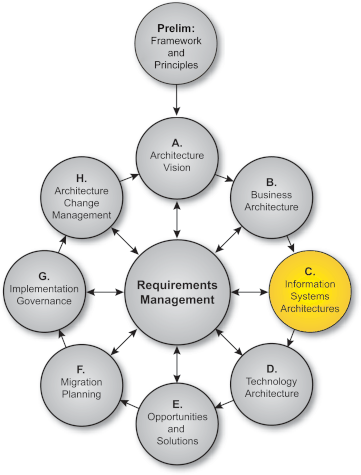Phase C: Information Systems Architectures
Objective |
Approach |
Inputs |
Steps |
Outputs
This chapter describes the Information Systems Architecture, including the development of Data and Applications
Architectures.

Figure: Phase C: Information Systems Architectures
Objective
The objective of Phase C is to develop Target Architectures covering either or both (depending on project scope) of the Data and
Application Systems domains.
The scope of the business processes supported in Phase C is limited to those that are supported by IT, and the interfaces of
those IT-related processes to non-IT-related processes.
Approach
Development
Phase C involves some combination of Data and Applications Architecture, in either order. Advocates exist for both sequences.
For example, Steven Spewak's Enterprise Architecture Planning (EAP) recommends a data-driven approach.
On the other hand, major applications systems - such as those for Enterprise Resource Planning (ERP), customer relationship
management, etc. - often provide a combination of technology infrastructure and business application logic, and some organizations
take an application-driven approach, whereby they recognize certain key applications as forming the core underpinning of the
mission-critical business processes, and take the implementation and integration of those core applications as the primary focus of
architecture effort (the integration issues often constituting a major challenge).
Implementation
Implementation of these architectures may not necessarily follow the same order. For example, one common implementation approach
is top-down design and bottom-up implementation:
- Design:
- Business Architecture design
- Data (or Applications) Architecture design
- Applications (or Data) Architecture design
- Technology Architecture design
- Implementation:
- Technology Architecture implementation
- Applications (or Data) Architecture implementation
- Data (or Applications) Architecture implementation
- Business Architecture implementation
An alternative approach is a data-driven sequence, whereby application systems that create data are implemented first, then
applications that process the data, and finally applications that archive data.
Inputs
Inputs to Phase C are:
- Application principles (Application Principles), if existing
- Data principles (Data Principles), if existing
- Request for Architecture Work (Request for Architecture Work)
- Statement of Architecture Work (Major Output Descriptions)
- Architecture Vision (Business Scenario/Architecture Vision)
- Enterprise Continuum (Introduction to the Enterprise Continuum)
- Baseline Business Architecture, Version 1.0 (detailed), if appropriate
- Target Business Architecture (Business Architecture), Version 1.0
(detailed)
- Baseline Data Architecture, Version 0.1
- Target Data Architecture, Version 0.1
- Baseline Applications Architecture, Version 0.1
- Target Applications Architecture, Version 0.1
- Relevant technical requirements that will apply to Phase C
- Gap analysis results (from Business Architecture)
- Re-usable building blocks (from organization's Architecture Continuum, if available)
Steps
Detailed steps for Phase C are given separately for each architecture domain:
Outputs
The main outputs are as follows:
- Statement of Architecture Work (Major Output Descriptions), updated if
necessary
- Baseline Data Architecture, Version 1.0
- Target Data Architecture, Version 1.0
- Baseline Applications Architecture, Version 1.0
- Target Applications Architecture, Version 1.0
- Data Architecture views corresponding to the selected viewpoints addressing key stakeholder concerns
- Applications Architecture views corresponding to the selected viewpoints addressing key stakeholder concerns
- Data Architecture Report, summarizing what was done and the key findings
- Applications Architecture Report, summarizing what was done and the key findings
- Gap analysis results:
- Areas where the Business Architecture may need to change to cater for changes in the Data and/or Applications Architecture
- Constraints on the Technology Architecture about to be designed
- Impact Analysis (see Impact Analysis)
- Updated business requirements (if appropriate)
return to top of page
Navigation
The TOGAF document set is designed for use with frames. To navigate around the document:
- In the main Contents frame at the top of the page, click the relevant hyperlink (Part I, Part II, etc.) to load the Contents
List for that Part of the TOGAF document into the Secondary Index frame in the left margin.
- Then click in that Contents List to load a page into this main frame.
return to top of page
Downloads
Downloads of the TOGAF documentation, are available under license from the TOGAF information web site. The license is free to any
organization wishing to use TOGAF entirely for internal purposes (for example, to develop an information system architecture for
use within that organization). A hardcopy book is also available from The Open Group Bookstore as document G063.
Copyright © 1999-2006 The Open Group, All Rights Reserved
TOGAF is a trademark of The Open Group

